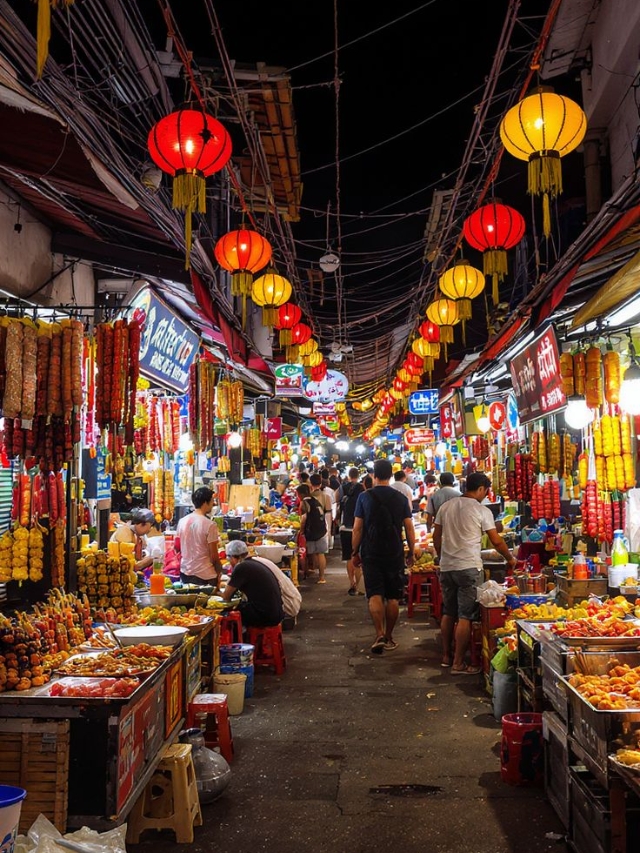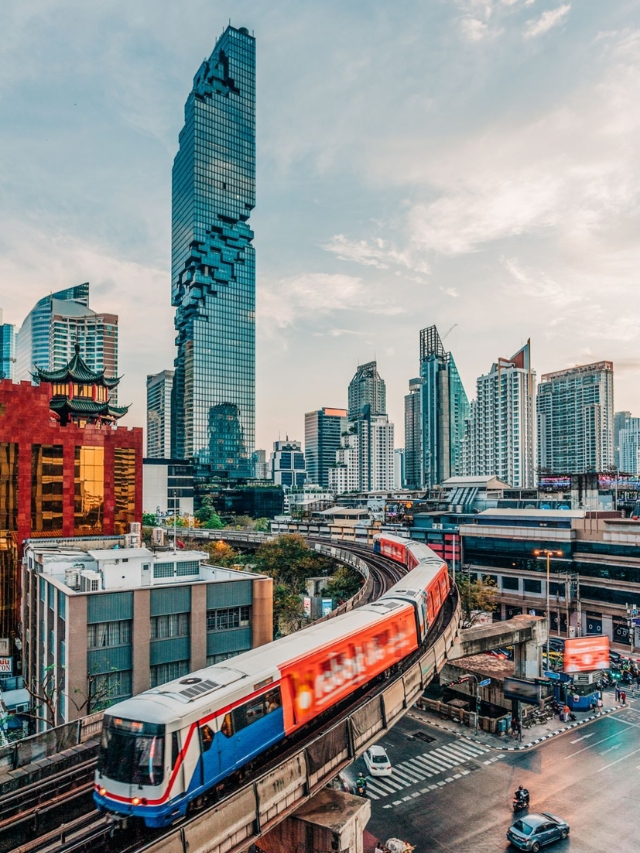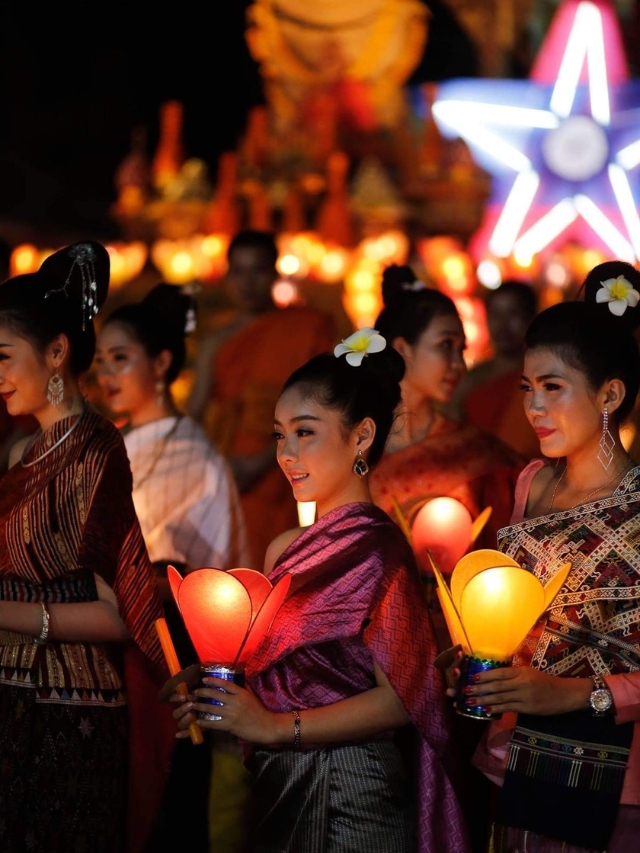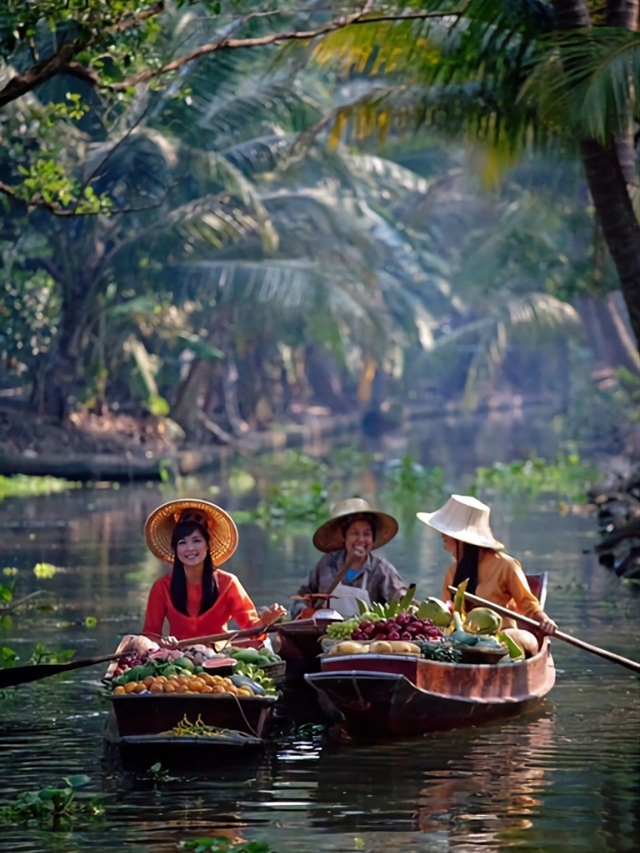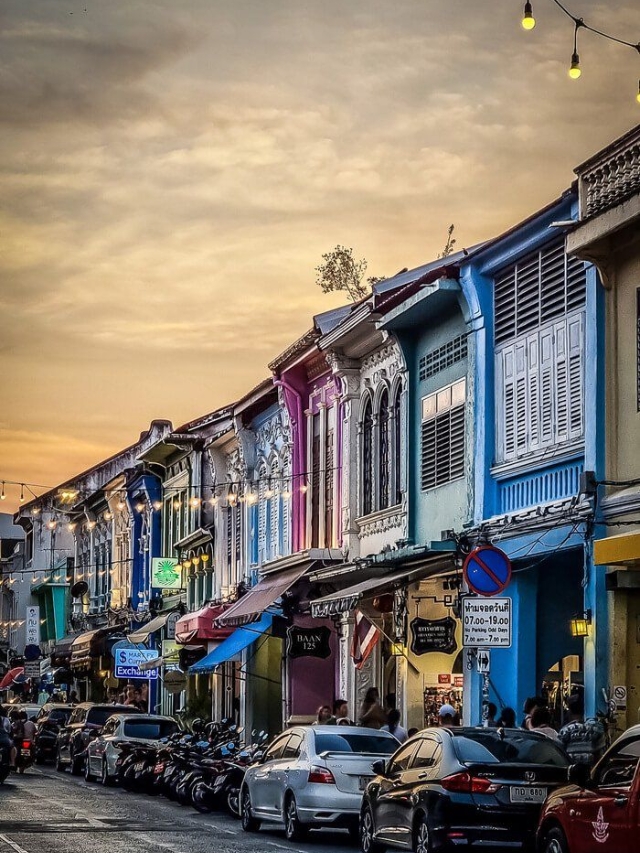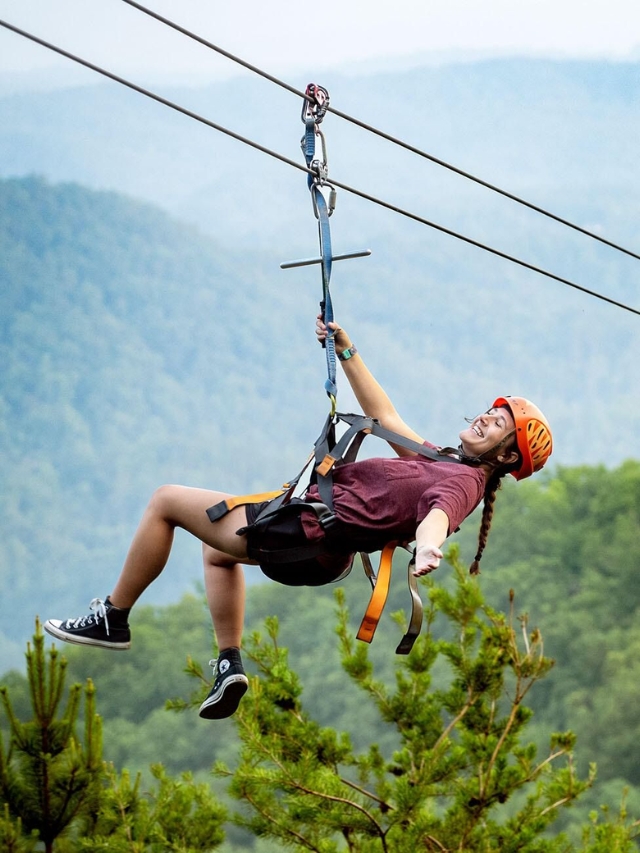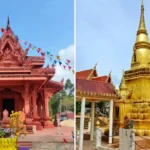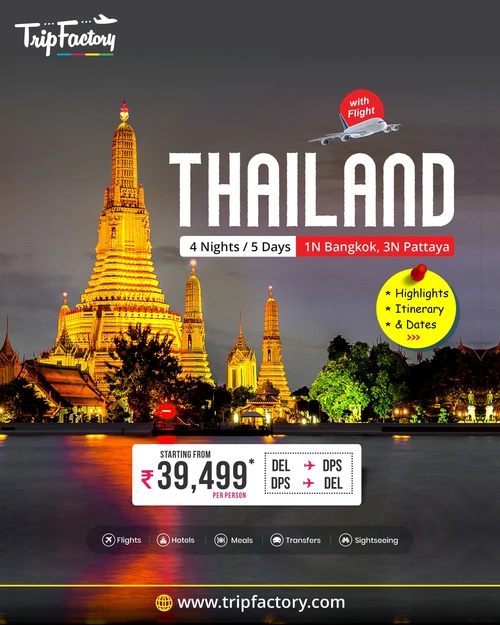Whether you are a first-time traveller to Thailand or a frequent visitor, this Place will always find a way to surprise you. From golden temples and bustling street markets to dreamy beaches and rich cultural traditions, Thailand is a destination that never disappoints.
If you’re traveling to Thailand, here are 10 things you should know before you go. In this article by TripFactory, we’ve covered everything from visas and currency to the best time to visit, food, and safety tips.
1. Visa Information
Before booking your flight, it’s Important to understand the current Thailand visa requirements. Entry policies can vary based on your nationality, the length of your stay, and the purpose of your visit. Knowing the right Thailand visa options will help you avoid any mistakes at immigration.
Documents Required for Visa on Arrival for Indian passport holders:
Visa Fee: 2,000 THB (approx ₹4,800), payable in Thai Baht only, at the immigration counter.
- Valid Indian passport (minimum 30 days’ validity from date of arrival)
- Recent passport-sized photograph (4 x 6 cm)
- Completely filled Visa on Arrival application form
- Return flight ticket within 15 days
- Proof of accommodation in Thailand
- Proof of sufficient funds (minimum 10,000 THB per person or 20,000 THB per family)
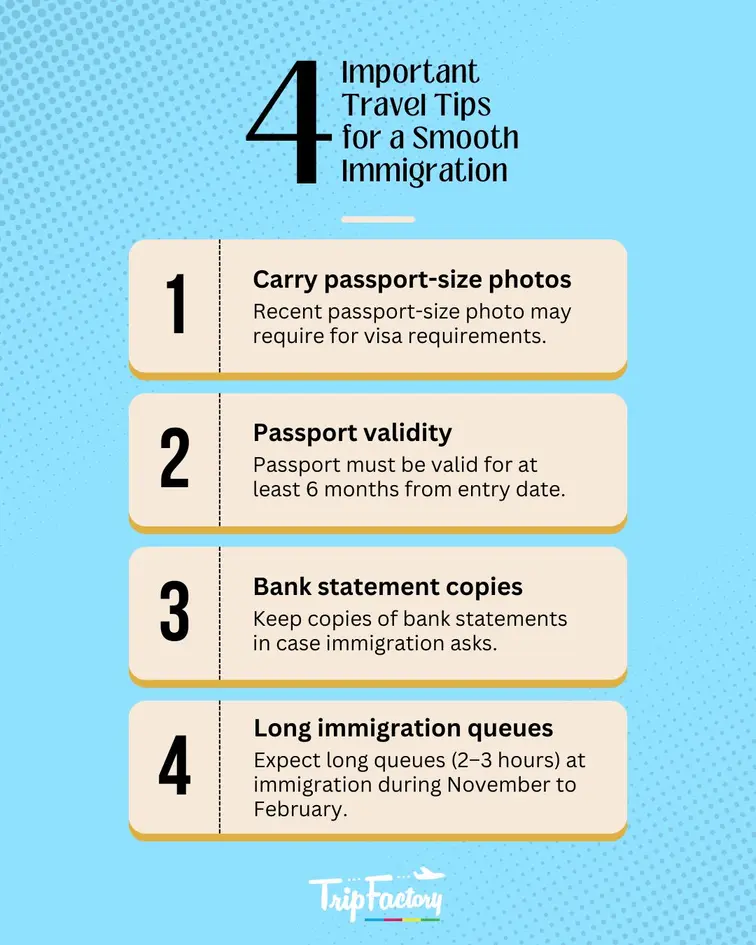
Online e-Visa on Arrival for the Indian option is also available (faster). Indian citizens can now apply for a Thailand e-Visa before travelling. This will help avoid any hassle at the airport during immigration. You can apply for e-Visa through: Official Thai e-Visa website (https://www.thaievisa.go.th/), and it will processed within 3-7 working days (apply at least 15 days before the departure).
2. Thai Currency
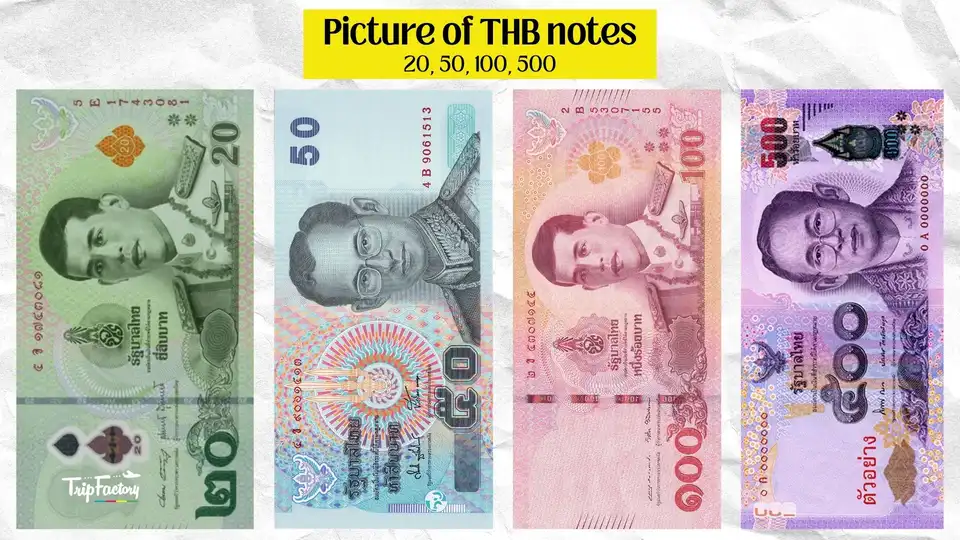
The currency used in Thailand is the Baht (THB), where approximately 1 THB is around 2.5 Indian Rupees, though it may vary.
- Carrying some Thai Baht from India or exchanging money at local currency counters once you arrive is advisable. Be cautious about airport currency exchange rates, as they tend to be less favourable. Local (especially in cities like Bangkok) currency counters offer much better rates than airport rates.
- While travelling, it’s important to carry both cards and cash. Use international debit or forex cards for major expenses, but also keep some cash handy for smaller purchases, street food, and shopping in local markets.
- Before entering Thailand, it is advisable to have at least ₹24,000 or more in Thai Baht before entering the country, as immigration officials may request proof of sufficient funds.
Tips To Avoid Scams:
- Airport currency exchanges (poor rates).
- Random street exchangers (risk of scams).
- ATM Withdrawals: Widely available around the city, but charge a flat 220 THB fee per transaction.
3. Best Time to Visit Thailand

Winter Season (November to February)
During the Winter season, it is considered the best time to travel to Thailand since temperatures range between 20 to 30 degrees Celsius, as it is perfect for travelling and exploring beaches and city explorations and also the availability of hotels and resorts is peak during this time. But it is better to do pre-booking due to high demand.
Summer Season (March to May)
Temperature, in Thailand, increases from the start of March to May and remains till the end of May, reaching temperatures above 30 degrees Celsius. But during the Summer, you can visit places like Koh Samui, a tropical paradise in Thailand’s Gulf, Ko Samet, Songkran Festival, the Thai New Year, famous for its water fights.
The best time to visit Thailand is from November to February, during the cool and dry season. The weather is pleasant and ideal for sightseeing, beach trips, and outdoor activities. Avoid the monsoon season (May to October), as heavy rains can disrupt travel plans.
Monsoon season (June to Oct)
From July to October. The rainy season brings lush landscapes and fewer tourists, offering a unique experience of rainfall along with beaches and the smell of the sea.
Also, keep in mind to check Thailand weather in May, specially you want to visit in this season.
The Best Places to visit in the monsoon season are Krabi, the capital of southern Thailand’s Krabi Province, and the Chiang Mai temple and Chiang Mai waterfall. Afternoon Showers, Great deals on hotels, fewer crowds at tourist spots and best affordable Thailand Tour Packages make it a unique experience for the travellers travellind during this season.
4. Respectful Behavior
Observing and respecting local culture will certainly enhance your experience in Thailand. Thailand is a deeply Buddhist country where people respect and believe in their kings and culture. It comes under strict laws not to show any disrespect to the Thai King, and clicking any Buddha Images, speaking against Buddha, or the monarchy can lead to arrest. Always be respectful around temples and images.
Temple Rules
- When entering temples or someone’s home, always remove your shoes, as it comes under common etiquette for local people
- Never touch Buddha statues, especially not climb on them for photos.
- Dress modestly, particularly when visiting religious places(no shorts, sleeveless tops, or revealing outfits)
Social Behavior
- Polite greetings like “Sawasdee” coupled with a smile go a long way in showing respect to locals.
- Smiling is generally considered a sign of respect and friendliness towards locals.
- Public displays of affection should also be avoided to ensure adherence to cultural sensitivities.
- Touching someone’s head (even children) is considered disrespectful to many people.
- Avoid pointing feet at Buddha’s statue in and outside of temples
- In Thailand, pointing with a finger, especially at local people, is considered highly disrespectful and should be avoided. If you need to indicate a person, the polite way is to subtly lift your chin or tilt your head slightly in their direction, rather than using your hands.
5. Food Tips for Indians
Thailand’s cuisine is generally celebrated, but it often comes with unexpected spice levels and may incorporate seafood for most Indian Travellers as which may not be appropriate for Indian taste buds. Still, Thailand offers a variety of foods that Indian travellers can enjoy according to their taste.
Before going to any Thai restaurant looking for vegetarian food options, you should know how to ask for it. Say “Mai gin nua sat” (vegetarian) at Thai restaurants. It means you are a vegetarian and want to eat only veg options.
While your trip to Thailand, you must try these dishes:
| Dish | Description | Ingredients | Spice Level | Vegetarian Notes |
|---|---|---|---|---|
| Mango Sticky Rice | 100% vegetarian, no fish oil added. Ask for no meat or fish sauce. | Sweet glutinous rice, fresh ripe mango slices, coconut milk. | Mild | Always vegetarian, but request no fish sauce or meat for a 100% veg option. |
| Fried Rice (Khao Pad) | Basic Thai fried rice. By default, it includes meat and egg. Can be made vegetarian on request. | Jasmine rice, vegetables, light soy sauce (sometimes vegetarian soy sauce), garlic, spring onions, optional tofu. | Mild | Request “Khao Pad Jay” (vegetarian fried rice), no egg, and no fish sauce for 100% veg. |
| Pad Thai | A flavorful, less oily dish. Generally contains egg, shrimp, and fish sauce. Can be made vegetarian. | Rice noodles, crushed peanuts, garlic, fresh vegetables (bean sprouts, carrots, green onions), light tamarind sauce. | Less Spicy | Ask for “Pad Thai Jay,” no egg, no fish sauce, and add more vegetables instead of meat for a purely vegetarian version. |
| Tom Yum Soup | A spicy and sour soup that is popular in Thailand. Often served with shrimp or chicken. | Lemongrass, kaffir lime leaves, galangal, mushrooms, chili, lime juice, fish sauce, and fresh herbs. | Spicy | Ask for “Tom Yum Jay” to make it vegetarian and request no fish sauce. It can be made with tofu instead of meat. |
| Green Curry (Gaeng Keow Wan) | A spicy and fragrant coconut-based curry with a variety of vegetables. Can be made with meat or tofu. | Green curry paste, coconut milk, bamboo shoots, eggplant, Thai basil, kaffir lime leaves, vegetables or tofu. | Spicy | Request “Gaeng Keow Wan Jay” for a vegetarian version and ask for tofu instead of meat. |
| Som Tum (Papaya Salad) | A fresh, spicy salad made with shredded green papaya and other crunchy veggies. | Green papaya, tomatoes, green beans, chilies, peanuts, lime, fish sauce, and palm sugar. | Spicy | Ask for “Som Tum Jay” and request no fish sauce for a vegetarian version. |
| Pad See Ew | Stir-fried flat rice noodles with vegetables, usually served with meat. | Flat rice noodles, soy sauce, broccoli, garlic, egg, and your choice of meat. | Mild | Request “Pad See Ew Jay” for a vegetarian version and ask for no egg or meat. |
| Massaman Curry | A milder, richer curry with Thai-Muslim influence. Usually served with meat but can be made vegetarian. | Massaman curry paste, coconut milk, potatoes, onions, peanuts, and your choice of meat or tofu. | Mild | Request “Massaman Curry Jay” for a vegetarian version, and ask for tofu instead of meat. |
6. Local Transport
Understanding the local transport system is essential for a smooth and enjoyable trip. In Thailand transport system is relatively straightforward:
For safe and reliable transportation, use the Grab App, which is similar to Uber and also the fares of the Grab App are more competitive than the local Taxi fares, Also, there is a chance that local drivers can charge extra fares to tourist people. It’s a great way to avoid being scammed or overcharged, especially in cities like Bangkok or Phuket.
Grab App availability: It operates in major Thai cities, including Bangkok, Pattaya, Chiang Mai, and Phuket.
Tips:
- Set your destination before getting in to avoid any confusion.
- Always check your fare estimate before confirming the ride.
- Avoid peak hours, like rush hour, to minimise long waiting hours.
Tuk-Tuks: Tuk-tuks provide a fun experience, but always negotiate the fare before starting your journey. These are colourful three-wheeled vehicles which are especially found in tourist-heavy places like Bangkok, Chiang Mai, and Phuket. Riding a tuk-tuk offers an experience you can’t get from a taxi or bus, also it is perfect for short-distance travelling and can easily enter through crowded markets and small alleys.
A short ride within city areas should cost around 40–100 baht, depending on the distance. Before Riding Tuk-Tuks, negotiate the Price. Unlike taxis, tuk-tuks don’t use meters, so you need to agree on the fare beforehand.
Bikes and Scooters: Renting a bike or scooter is an excellent way to explore Thailand on your terms. From the busy streets of Bangkok to the relaxed coastal roads of Koh Samui and Phuket, two-wheeled transport is popular among both locals and tourists.
But ride only if you have experience, and always wear helmets for safety.
Ferries and speedboats: If you’re going to explore an island, then Ferries and speedboats are the best option to travel across various Islands since there are many islands to explore, like Koh Phi Phi, Koh Samui, Koh Tao, or Krabi, ferry services are essential.
7. Bag Packing Tips
When you are travelling, packing wisely is the key to having a smooth and enjoyable trip. Here’s a comprehensive guide to help you pack the right essentials for your adventure in Thailand.
| Packing Item | What to Pack | What to Avoid |
|---|---|---|
| Light Cotton Clothes | T-shirts, tank tops, shorts, light skirts, cotton clothes for hot and humid days. | Tight clothing, synthetic fabrics like polyester. |
| Loose-Fitting Items | Loose clothing for comfort, as tight clothing can be uncomfortable in the heat. | Tight, restrictive clothing. |
| Neutral & Light Colours | Light colours like white, beige, pastels to reflect the sun and keep cool. Avoid dark colours. | Dark colours like black (they absorb heat). |
| Sunscreen & Sunglasses | High-SPF sunscreen (SPF 30 or above), UV-blocking sunglasses, wide-brimmed hat, light umbrella. | Forgetting sun protection essentials. |
| Swimwear & Flip-Flops | Comfortable swimwear, flip-flops or waterproof sandals, waterproof beach bag, beach towel (light, quick-dry). | Heavy shoes or sandals not suited for the beach. |
| A Light Jacket for Cooler Regions | Light jacket or sweater for cooler northern regions like Chiang Mai, especially in the evenings. | Heavy jackets or unnecessary winter wear. |
| Power Bank & International Adapter | Power bank (10,000mAh or higher), international adapter (Type A, B, and C plugs), solar charger (optional). | Forgetting to carry your own adapter or power bank. |
8. Mobile & Internet
While travelling to other countries, staying connected is important for navigating through cities, booking rides, keeping in touch with friends and family, or finding the best local spots to visit. Fortunately, Thailand offers an excellent mobile and internet infrastructure, making it easy for travellers to access essential services like Google Maps, Grab rides, and even book accommodations online.
The best way to stay connected in Thailand is by purchasing a local SIM card. Major airports like Suvarnabhumi (Bangkok), Don Mueang (Bangkok), and Phuket International Airport have shops that sell SIM cards from AIS, DTAC, and TrueMove, the three leading mobile providers in Thailand.
Why Buy a Local SIM?
There are 3 reasons to buy a local SIM while your vacation in Thailand. First reason is Local Support, if you encounter any issues, customer service is readily available in both Thai and English, making it easy to resolve problems.
Then Affordable Rates, as local SIM cards are much cheaper than using international roaming services from India. And the last and final one is Convenience. If you’ve local Thailand SIM, you don’t need to worry about high roaming charges to use Google Maps, Grab, and other useful apps.
9. Safety Tips While Travelling in Thailand
Thailand is generally considered a safe country for travellers, but like any popular tourist destination, it does have its share of scams and situations where caution is necessary. It’s important to stay alert and be aware of common safety concerns and scams that might pop up during your travels.
Here we’ve shared some tips for staying safe in Thailand, avoiding scams, and enjoying your vacation with peace of mind.
What You Should Do:
- Stay Aware of Your Surroundings: Keep your belongings close and be cautious in crowded places like markets, malls, and public transport hubs.
- Use Secure Bags: Opt for a cross-body bag with zippers and keep it in front of you to avoid pickpockets. Avoid carrying large amounts of cash or flashy valuables that could attract unwanted attention.
- Stick to Well-Lit Areas at Night: If you’re walking around at night, stick to well-lit streets and avoid alleyways or poorly lit areas, especially in cities like Bangkok or Pattaya.
- Always Double-Check Taxi Prices: Ensure you confirm the fare before getting into a taxi or use reliable transport apps to avoid overcharging.
- Keep Your Belongings Secure: Avoid leaving your items unattended, especially on beaches or in public spaces.
What You Should Avoid:
- Avoid Over-Friendly Strangers Offering “Special” Tours
A friendly local may approach you, often near popular tourist spots or on your way to a temple, offering a special deal on a tour or a visit to an “exclusive” location. They might promise an incredible experience at a discounted price, but the reality is that you may end up in a tourist trap with high costs or have a bad experience. Some scammers even dress as monks and approach tourists asking for donations for a “good cause.” In reality, these are not real monks but scammers who pocket the money. - Don’t Leave Belongings Unattended on Beaches
Be cautious about leaving your belongings unattended, especially on beaches, as they can easily be stolen.
if you’re still planning and want to make your Thailand tour headache free, you should prefer booking a Thailand tour package. TripFactory’s tour packages typically cover hotels, transportation, and sightseeing, making ideal for first-time visitors or families.
Conclusion
Travelling to Thailand can be a wildly enriching experience filled with culture, cuisine, and breathtaking landscapes. By respecting local customs, navigating transportation thoughtfully, timing your visit wisely, and savouring the delicious food, you can create memorable experiences that deepen your appreciation for this beautiful country.
Thailand is a warm, welcoming destination that is easy on the wallet. However, knowing a few essential things beforehand can enhance your experience significantly. Keep this checklist handy, and enjoy your adventure in the Land of Smiles with confidence.
Check Latest Stories:
- Chedi Wat Khao Hua Chuk: Location, Timings Things to Do & SeeKhao Hua Jook Chedi is one of Koh Samui’s most peaceful viewpoints. It’s on a… Read more: Chedi Wat Khao Hua Chuk: Location, Timings Things to Do & See
- The Secret Buddha Garden: Location, Timings, Things to Do & SeeThe Secret Buddha Garden, also called the Magic Garden, Heaven’s Garden, or Tarnim Magic Garden,… Read more: The Secret Buddha Garden: Location, Timings, Things to Do & See
- Wat Sila Ngu: Location, Timings, Things to Do & SeeIt is one of Koh Samui’s most beautiful and important temples. The name comes from… Read more: Wat Sila Ngu: Location, Timings, Things to Do & See
- Wat Khunaram: Location, Timings Things to Do & SeeWat Khunaram is one of the most interesting and spiritually charged temples on Koh Samui,… Read more: Wat Khunaram: Location, Timings Things to Do & See
- Wat Plai Laem: Location, Timings Things to Do & SeeWat Plai Laem is one of the most beautiful and lively temples on Koh Samui.… Read more: Wat Plai Laem: Location, Timings Things to Do & See


